|
Jazz Essentials, Part 3
Here are six essentials of
the
jazz vocal art
By Tom Ineck
In the
second installment of “Jazz Essentials,” we recommended five examples
showcasing the early architects of jazz. Among them, of course, was
Louis Armstrong, who was influential not only for the bravura trumpet
playing that set the standard for jazz improvisation in a group setting,
but also for his impact on the jazz vocal art. He not only vocalized
with the rhythmic swing and phrasing of an instrument, but also
introduced the popular use of scat-singing, often employed when words
failed to impart the proper lilt or wit to a given piece of music. Using
Armstrong as a springboard to the great jazz singers who followed, we
now turn our attention to six more important vocalists of jazz history.
Bing
Crosby is best known for his huge popularity as a singer of pop and
novelty tunes, a star of radio and TV, and an actor of incredible range,
from wacky comedy to heart-rending pathos. But he began as a jazz singer
greatly inspired by Louis Armstrong. A contemporary of Armstrong, Crosby
influenced countless crooners, including Frank Sinatra. Despite her
limited vocal range, Billie Holiday combined an appreciation for
the blues, an innate sense of swing, unusual phrasing and a gift for
conveying and evoking intense emotions. Unlike most singers who had come
before her, she occupied a high, middle ground between the straight
blues interpretations of singers like Bessie Smith and the dull,
uninflected delivery of most Tin Pan Alley songsters. There was no
greater swinger among singers than Ella Fitzgerald. A
near-contemporary of Billie Holiday—born two years later—Fitzgerald
raised the vocal art to a pinnacle with her unerring pitch, her wide
range and her sense of irrepressible joy in every tune. Throughout a
career spanning nearly 60 years, she introduced new material with a
curious zest, even when it seemed inappropriate or beneath her talents.
Sarah Vaughan possessed pipes of operatic potential, capable of
multi-octave leaps with a wonderfully controlled vibrato. A transitional
jazz singer, Vaughan began her career in the swing era but adapted well
to the new sounds and rhythms of bop in the late 1940s. Like Armstrong,
Nat King Cole is equally important as an instrumentalist and a
singer. His influential piano trio of the late 1930s and 1940s was one
of the few to eschew a drummer in favor of a guitarist. Like Crosby, he
became a singer of pop standards and occasional novelty songs and was a
multi-media star of records, television and movies.
As with
other early artists who we have recommended as essentials in any jazz
collection, we will focus primarily on multi-disc anthologies. Since
recordings of the 1930s and 1940s were initially available only on 78
rpm discs, and even later LPs can be uneven and incomplete examples of
the artist’s work, we will suggest more representative collections.
BING CROSBY
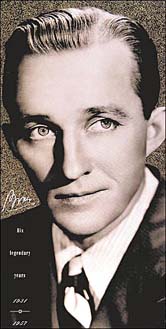 Bing!
His Legendary Years, 1931-1957 Bing!
His Legendary Years, 1931-1957
MCA
Records
This
four-disc set from 1994 is the best package of Crosby’s best years. It
documents the arc of his career from the early jazz years, through the
crooning radio and film years of the 1940s and into the modern pop-song
television era. In doing so, it accomplishes the monumental task of
representing all styles with which he is most often associated—swing,
ballads, novelties, cowboy songs, holiday tunes and even the travel
trifles of Hawaii and Ireland.
Among the
early gems included are “I Found a Million Dollar Baby,” “Dancing in the
Dark” and “Stardust.” From Crosby’s popular holiday songbook are “White
Christmas,” “Silent Night,” “O Come All Ye Faithful,” and “Silver
Bells.” But the lion’s share of this 101-song collection is devoted to
the standards of the Great American Songbook as interpreted with that
marvelous, unmatched Crosby baritone.
For
listeners who want more of Crosby from a particular period, we recommend
additional jazz recordings from the late 1920s and early 1930s and—for
that nostalgic sleigh ride down Santa Claus Lane—a whole album of
Christmas music.
BILLIE HOLIDAY
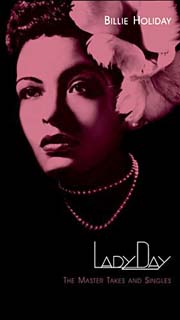 Lady
Day: The Master Takes and Singles Lady
Day: The Master Takes and Singles
Columbia
Legacy Records
When it
comes to Billie Holiday’s most fruitful years on Columbia records, fans
have several formats from which to choose. Those on a limited budget can
go with the single-disc “God Bless the Child” from 1996 or 2001’s
double-disc “Lady Day: The Best of Billie Holiday.” For the completist,
there is the 10-CD “The Complete Billie Holiday on Columbia
(1933-1944),” also released in 2001.
We
recommend the middle path, the wonderful four-disc 2007 entry entitled
“Lady Day: The Master Takes and Singles,” a collection of 80 superb
recordings made between 1935 and 1942. The sound is great, the
selections are unimpeachable, and the performances are flawless,
reaffirming Holiday as likely the best jazz singer of all time.
Of course,
it helps that she is accompanied by some of the great players of the
era, including pianist Teddy Wilson, saxophonists Lester Young, Ben
Webster, Chu Berry and Johnny Hodges, clarinetists Benny Goodman, Artie
Shaw and Jimmy Hamilton, trumpeters Harry “Sweets” Edison, Roy Eldridge,
Buck Clayton and Charlie Shavers, guitarists Freddie Green, Dave Barbour
and John Collins, bassists Milt Hinton, John Kirby and Walter Page, and
drummers Jo Jones, Kenny Clarke, and Gene Krupa.
ELLA FITZGERALD
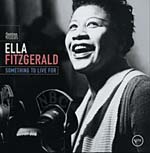 Something
to Live For Something
to Live For
Verve
Records
Fitzgerald
recorded from the early 1930s well into the 1980s—an incredible
output—and much of it is first-rate. But we give the nod to this 1999
two-disc collection of 30 songs, ranging from 1935 to 1966. “Something
to Live For” is a companion to the TV documentary of the same name,
which appeared on the PBS series “American Masters.”
Importantly, it contains eight selections from her early years with
Decca, including the iconic “A-Tisket, A-Tasket.” Among the other career
highlights are “How High the Moon,” “But Not for Me,” “Ridin’ High,”
“Angel Eyes,” a live and swinging version of “Oh, Lady Be Good,” “The
Lady is a Tramp,” “Body and Soul,” the scat masterpiece “Airmail
Special,” “Mack the Knife,” “Mr. Paganini,” and one of her many
excellent renditions of “’Round Midnight.”
Like
Holiday, Fitzgerald got the sidemen she so richly deserved. Among those
included here are pianist Oscar Peterson, saxophonists Colman Hawkins,
Lester Young, Ben Webster, Stan Getz, Illinois Jacquet, Flip Phillips
and Sonny Stitt, trombonist J.J. Johnson, trumpeters Harry “Sweets”
Edison and Roy Eldridge, guitarists Herb Ellis and Barney Kessel, and
bassist (and former husband) Ray Brown.
SARAH VAUGHAN
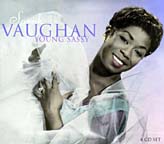 Young
Sassy Young
Sassy
Proper
Records
We can
recommend 2001’s “Young Sassy,” without reservation, for a number of
reasons. Whereas early recordings of Holiday and Fitzgerald were often
inferior to their later work—usually due to weak material—Vaughan’s
beginnings were more auspicious. Her voice was always magical, and the
tunes here are largely drawn from the standards. Also, this four-disc
collection contains her entire output between 1944 and 1950, an amazing
94 songs, at the very reasonable cost of less than $30.
Few can
complain about a set list that includes “East of the Sun (and West of
the Moon),” “Lover Man,” “Mean to Me,” “You Go to My Head,” “It Might as
Well Be Spring,” “I’ve Got a Crush on You,” “Body and Soul,” “Time After
Time,” “I Cover the Waterfront,” “Tenderly,” “Love Me or Leave Me,” “The
Nearness of You,” “Come Rain or Come Shine,” and “Black Coffee.”
Great
thanks are due the folks at Proper Records, a UK label that has released
dozens of modestly priced collections of jazz, blues, country and other
great American music in recent years.
NAT KING COLE
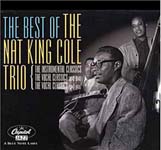 The
Best of the Nat King Cole Trio: The Instrumental Classics/The Vocal
Classics The
Best of the Nat King Cole Trio: The Instrumental Classics/The Vocal
Classics
Blue Note Records
Since Nat Cole’s later recordings often
suffer from a poor choice of material and overproduction, it is wise to
start at the beginning. The three discs included in “Best of Nat King
Cole: The Instrumental Classics/The Vocal Classics” present 62 tracks
from the trio’s productive years of 1944 to 1950. The instrumental and
vocal excellence presented here may come as a surprise to the
unfortunate listener who knows only the Nat King Cole of “Ramblin’
Rose,” “Mona Lisa,” “Those Lazy, Hazy, Crazy Days of Summer” and “Cat
Ballou.”
Among the most notable selections here are
“Sweet Georgia Brown,” “Honeysuckle Rose,” “How High the Moon,”
“Straighten Up and Fly Right,” “It’s Only a Paper Moon,” “Sweet
Lorraine,” “Frim Fram Sauce,” “Route 66,” “Meet Me at No Special Place,”
“When I Take My Sugar to Tea,” “Too Marvelous For Words,” and “For all
We Know.”
Cole’s satiny voice, impeccable piano
playing and warm delivery require no strings, horns or other production
“values,” which often weakened his later recordings. That is what makes
these trio sides so important and so supremely listenable. By the way,
we must pay our respects to the other players that make these recordings
so timeless: Oscar Moore and Irving Ashby alternating on guitars, and
Joe Comfort and Johnny Miller alternating on bass.
FRANK SINATRA
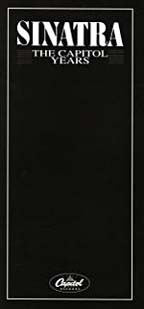 The
Capitol Years The
Capitol Years
Capitol
Records
Few critics
disagree that Sinatra’s middle period, his Capitol years from 1953 to
1961, produced his finest hours of recorded music in a career than
spanned six decades. You can’t go wrong with any of the individual
releases of the Capitol decade, so why not own them all? Either save up
your money and purchase this 21-CD boxed set or buy the CDs
individually, as I have over the last decade or so.
This 1998
EMI British import gets kudos for its purportedly superior sound over
the individual domestic re-masters that were issued in the late 1990s
and early 2000s. The box contains each of the original LPs packaged as a
separate CD, with an additional disc compiling bonus tracks entitled
“The Rare Sinatra.” The mammoth 272-track collection is also
outrageously expensive, upwards of $600. Proponents claim that Sinatra’s
voice is brighter, more alive, here than on the U.S. versions, but these
esoteric arguments are subjective and fail to justify the cost, unless
you happen to be independently wealthy.
For those
of us who have to work for a living—and who have other music on our wish
list—the way to go is to acquire the U.S. Capitol reissues as singles,
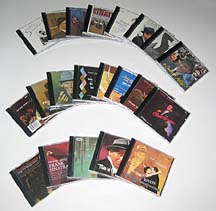 for
around $12 each. That way, you also get the bonus tracks that are added
to each CD, expanding the length beyond the original 30 minutes or so.
Most of Sinatra’s Capitol recordings are classics, so you can’t go wrong
by either purchasing them chronologically or by going for your favorites
first. Eventually, you should own “Songs for Young Lovers/Swing Easy”
(1954), “In the Wee Small Hours” (1955), “Songs for Swingin’ Lovers”
(1956), “A Swingin’ Affair” (1957), “Where Are You?” (1957), “Come Fly
With Me” (1958), “Only the Lonely” (1958), “Come Dance with Me” (1959),
“No One Cares” (1959), and “Nice and Easy” (1960). These 10 recordings
represent a seven-year run of brilliance unparalleled in American
popular song. for
around $12 each. That way, you also get the bonus tracks that are added
to each CD, expanding the length beyond the original 30 minutes or so.
Most of Sinatra’s Capitol recordings are classics, so you can’t go wrong
by either purchasing them chronologically or by going for your favorites
first. Eventually, you should own “Songs for Young Lovers/Swing Easy”
(1954), “In the Wee Small Hours” (1955), “Songs for Swingin’ Lovers”
(1956), “A Swingin’ Affair” (1957), “Where Are You?” (1957), “Come Fly
With Me” (1958), “Only the Lonely” (1958), “Come Dance with Me” (1959),
“No One Cares” (1959), and “Nice and Easy” (1960). These 10 recordings
represent a seven-year run of brilliance unparalleled in American
popular song.
Once you
have satisfied your appetite for Sinatra’s greatest period, supplement
your collection with something from his early years with Columbia
Records and his later years on the Reprise label. Try to find the
four-disc, 97-track “Best of Columbia Years 1943-52,” released in 1998,
and go with either 1990’s, four-disc “The Reprise Collection” or “The
Very Best of Frank Sinatra,” an excellent double-disc, 40-track overview
of the Reprise years released by Warner Bros. in 1997. Happy listening!
top
|

 Bing!
His Legendary Years, 1931-1957
Bing!
His Legendary Years, 1931-1957 Lady
Day: The Master Takes and Singles
Lady
Day: The Master Takes and Singles Something
to Live For
Something
to Live For Young
Sassy
Young
Sassy The
Best of the Nat King Cole Trio: The Instrumental Classics/The Vocal
Classics
The
Best of the Nat King Cole Trio: The Instrumental Classics/The Vocal
Classics The
Capitol Years
The
Capitol Years for
around $12 each. That way, you also get the bonus tracks that are added
to each CD, expanding the length beyond the original 30 minutes or so.
Most of Sinatra’s Capitol recordings are classics, so you can’t go wrong
by either purchasing them chronologically or by going for your favorites
first. Eventually, you should own “Songs for Young Lovers/Swing Easy”
(1954), “In the Wee Small Hours” (1955), “Songs for Swingin’ Lovers”
(1956), “A Swingin’ Affair” (1957), “Where Are You?” (1957), “Come Fly
With Me” (1958), “Only the Lonely” (1958), “Come Dance with Me” (1959),
“No One Cares” (1959), and “Nice and Easy” (1960). These 10 recordings
represent a seven-year run of brilliance unparalleled in American
popular song.
for
around $12 each. That way, you also get the bonus tracks that are added
to each CD, expanding the length beyond the original 30 minutes or so.
Most of Sinatra’s Capitol recordings are classics, so you can’t go wrong
by either purchasing them chronologically or by going for your favorites
first. Eventually, you should own “Songs for Young Lovers/Swing Easy”
(1954), “In the Wee Small Hours” (1955), “Songs for Swingin’ Lovers”
(1956), “A Swingin’ Affair” (1957), “Where Are You?” (1957), “Come Fly
With Me” (1958), “Only the Lonely” (1958), “Come Dance with Me” (1959),
“No One Cares” (1959), and “Nice and Easy” (1960). These 10 recordings
represent a seven-year run of brilliance unparalleled in American
popular song.